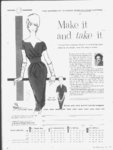| OCR Text |
Show & -- JSJN A noted social historian takes you on a picturesque tour of swimming holes through the ages. Heres what women have worn and not worn on the beach from B.C. to the Bikini 1 This "T A 7Tien I was a small boy at Horse Neck Beach V V in Massachusetts before World War I, my mother wore a "bathing dress which had bloomers and a skirt, both of which came to just below the knees. The bloomers had ruffles on1 them, and Mother wore black stockings and black cloth bathing shoes with laces. The top was a sort of middy blouse with white tapes stitched to 'the sailor collar. The sleeves came to her elbows. Under such discreet bathing dresses as this, women wore boned corsets. Though water, and especially salt water, was considered healthful, the sun was an enemy. A womans pride was her delicate skin. To expose it to toughening and darkening was unthinkable, and she protected it with veils and gloves and scarves and hats Weeks Guest Expert SMALLEST SUITS ARE BIGGEST NEWS IN 1960 Bathing suits, as Mr. Lynes points out, vary strangely from age to age. This summer theyre going to vary in a direction that will have male beachcombers adjusting their sunglasses. We show you seven items worth watching for if youre a man, and worth wearing if you're a girl (and have the right figure to fit in them) : A. Gemreich Two-piec- e wool suit by Rudi Rose ($22). for Charles - Low cut, back and front, by Cole of California ($23) . tics C. Cotton Bikini with let-ofrom Rose Marie Reid ($16). D. Low back, slit front (see toffof page), John Weitz, Elan ($20). i rv t ? - Tiny Bikini by Jantzen ($11). F. Tank suit with slits front and back, by Gemreich ($22). On Page 17: by Gemreich, one e look ($22). piece with a two-piec- .1 li The circa-190- 5 swimming dress above, courtesy of the Costume Institute of the Metropolitan Museum of Art. Beach towel in Cone terry from Earl Bernard. Hats by Gobbi. when she was not on the beach, and with umbrellas and parasols and the striped awnings of cabanas when she was. Her bathing dress often avoided even a "V neck, lest the sun and reflection from the sand tint her throat with pink. Only a few years before my parents took me to the beach, "mixed bathing had been looked upon as the sort of thing in which nice people did not indulge. Men had their part of the beach anti women had theirs, or they used the beach at different times of the day. Most women limited their activities in the water to the simple process of dunking; to swim in serge bathing dresses weighted with water must have been like trying to swim with a sandbag tied around the neck. Ladies went "bathing, not "swimming. But the farther you go beyond the last century the less bathing suit you find. The Greeks did not think it decent to approach the water in any costume that nature had not provided for the bath, and in Sicily, mosaic pavements from about 400 a.d. show Roman girls in a costume precisely like the modern Bikini. During the Dark Ages bathing of any kind was frowned upon as a sinful indulgence of the flesh; the practice had got a bad name from the libidinous excesses of the Roman baths. When occasional bathing was revived in the Middle Ages, men a id women not infrequently bathed ingroups in large tubs across which they set boards with food on them. Since, they had to go to a great deal of trouble to fill their large round tubs with warm water from pails and ewers they, quite naturally, made the most of the occasion. They shared these baths in the altogether and the practice was taken for granted. English discover th baoch But beach bathing was to all intents and purdiscovery, reports English poses an historian James Laver. In England in 1750 Dr. Richard Russell published a paper extolling the healthful virtues of sea water, both internally and externally, and he built himself a summer house at Brighton. Little did he realize that he was the man responsible for Coney Island, but seaside resorts became popular vacation spots and bathing in the health customs of sea soon replaced "taking the waters at spas and immersion in sulphurous springs. Swimming, as we know it, and jumping in and out of the surf were a far cry from the strange practices of early beach life. Then men and women were taken out into the water in a "bathing machine which had a huge umbrella-likcover. "Bathing men and "bathing women, according to historian Laver, 'seized them in strong arms and plunged them beneath the surface of the water, taking care to see that they swallowed as great a quantity as At first the costume for postible in the process. this exercise was none at all, since the bathers were concealed by the machines, but soon the ladies Continued on page 22 affected a Th 18th-centur- y the-ol- der e full-lengt- h 19 |










































































































































































